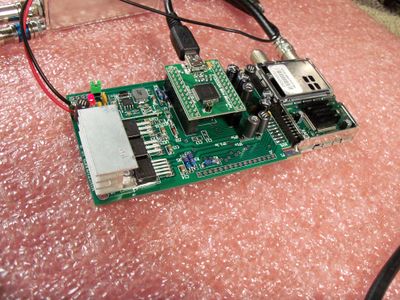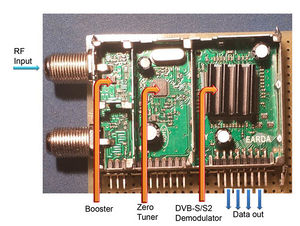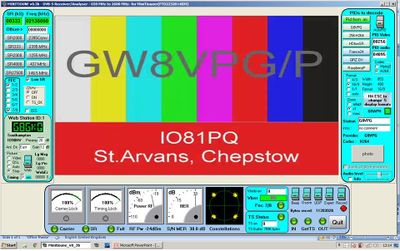MiniTioune
The MiniTioune USB receiver project consists of software (MiniTioune )and hardware (MiniTiouner) and is developed by Jean-Pierre F6DZP for receiving digital TV transmissions.
It can be used to receive DVB-S QPSK and DVB-S2 QPSK, 8PSK, 16APSK, 32 APSK from broadcast and amateur TV transmissions with symbol rates (SR) from 30 Msymbols down to 120 Ksymbols per second enabling it to receive satellite broadcasts, "normal" DATV signals and Reduced Bandwidth (RB-TV) transmissions.
Definitions
The following terms should be used when describing this project - note "MiniTiouner" is the French project name but maybe pronounced "Minituner" in English.
- MiniTioune = PC software
- MiniTiouner = The complete project hardware with USB interface - this can be prefixed with the type of tuner eg "Sharp Minitiouner"
- NIM = Network Interface Module. The little metal box that we find inside most of Satellite Receivers (also called the tuner) - contains the RF and demodulation circuits.
Hardware overview
Full details of the MiniTiouner hardware and build information are available here
The NIM
A typical NIM consists of 2 chips : the Zero Tuner and the Demodulator. RF Signal is sent to the antenna connector "RF input", it is amplified by a transistor "booster", the zero tuner selects the frequency asked and the demodulator extracts the data (Transport Stream) that goes outside the NIM on a digital parallel output.
The BATC shop used to sell a Sharp and Eardetek NIM with frequency coverage from 650 MHz through to 2600 MHz. (DVB-S and DVB-S2 QPSK and 8PSK). As of February 2017 the Sharp, Samsung and Serit SP2246 tuners are no longer available and the project now uses a NIM tuner from Serit (model FTS4335) which covers from 143.75 MHz right through to 2450 MHz without the need for any upconverters.
This extended frequency coverage gives greater flexibility and means up converters from the VHF and UHF bands are not required and enables the 10 GHz band, including Es'HailSat-2 down link, to be received on a standard domestic PLL LNB.
This makes building a receiver for 146 or 437 much easier, although you will need a pre-amp followed by lots of filtering for each band, just like the Sharp did, and probably followed by a Satellite line amp from ebay as the Serit has less gain than the Sharp.
However, due to a different pinouts from the Sharp NIM, the Serit FTS4335 NIM tuner will also need a simple adapter board to enable it to be plugged in to the MiniTiouner standard hardware - Brian G4EWJ has designed a board and these are available from the BATC shop.
The board and the Serit FTS4335 NIM tuner are available from the BATC shop. Full details of this board and using the tuner are available here.
Note the project also worked with an earlier Serit tuner (SP2246) but none were sold by the BATC
So what do I need to buy?
The Minitiouner hardware is designed for home construction and consists of 3 major components – the Tuner or NIM, the USB interface and PCB containing the power supply components.
- The USB interface can be bought ready programmed from the BATC shop.
- The main PCB can also be bought from the BATC shop although we are currently (April 2017) redesigning the board for one that will take the Serit tuner directly.
- The tuner or NIM.
The tuner (NIM), pre-programmed USB interface module and a blank PCB are available from the BATC on line shop https://batc.org.uk/shop/hardware-and-kits – all other components are available from normal suppliers.
Full details on how the build the MiniTiouner including a "how to video" and a zip file containing circuit diagram, layout and build instructions can be found on the MiniTiouner hardware wiki page. Please note the “full kit” mentioned in documentation is no longer available.
Band Pass filters
There is a whole section of the wiki dedicated to this most important part of your system - take a look at the pictures on the top of this page to see why you must use filters before your MiniTiouner!
Receive upconverters
The new Serit NIM FTS4335 covers 143.75 - 2450 MHz and does not require any external frequency converters.
As mentioned above, the Sharp tuner component (also called NIM) used in a MiniTiouner covers a maximum of 650 to 2600 MHz.
Whilst this is fine for the 23cms (1.3 GHz) and 13cms (2.3 GHz) amateur bands it does not provide coverage of 146 (2mts) and 437 MHz (70cms) where the majority of ATV operation takes place. Therefore we need to use an upconverter in front of the tuner which converts 146 MHz and 437 MHz up to an L band frequency that the MiniTiouner will receive.
A separate section on the wiki gives details of these upconverters.
Software
The system uses free to download DVB-S receive and analysis software called "Minitioune" written by F6DZP. The Software is hosted on the VivaDATV forum. You need a log-in to download, but here are the links:
The latest (28 February 2017) version of MiniTioune V0.6d: Minitioune v0.6d download
Noise Power Measurement Software: ( included in the Minitioune software package)
Software Installation
There is a "readme.pdf" in the Minitioune software package that gives the latest information and a step by step guide
For a step by step guide on how to do this, see the paper written by W6HHC - http://www.w6ze.org/DATV/InstallingMiniTiouner_onWin10.pdf
- Install the D2XX drivers 2.12.24 found at http://ftdichip.com/Drivers/D2XX.htm. There's a link in the right column for a setup executable. This stage is missing from W6HHC notes.
- Install the FT2232H USB driver for the MiniTiouner board
- Inspect the FT2232H USB-controller module (preprogramed by BATC for NIMtuner) for correct internal memory programming
- Install LAVfilters CODECs and test the HW board and test the DirectShow filters
- Look in the Minitiouner folder that you've just copied to C:\ for the small program "Install_usrc_ax_winXP" and run this to install the link with the decoder.
- Run the MiniTiouner_v0.6d executable & perhaps adjust the decoder filters being used.


